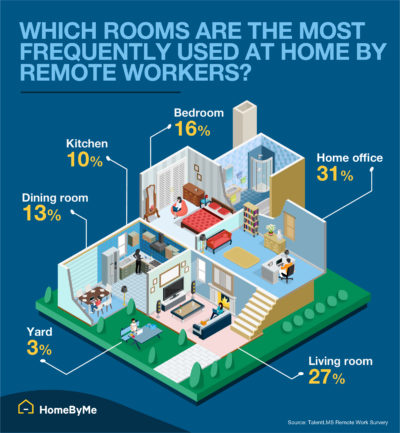Design trends June 12, 2020
How home retailers can utilize 3D planning solutions to tap into the hybrid homes trend and the rise of at home offices

A global rapid increase in self-employment and remote working opportunities has resulted in the re-evaluation of home designs.
Home designs must now cater to both living and working environments under one roof.
According to research by Owl Labs, 52% of employees globally now work from home at least once per week and 68% at least once per month, citing benefits such as a reduced commute or increased productivity. In turn, companies that offer remote working opportunities are benefiting from a decrease in employee turnover of approximately 25%, along with improved staff morale. Telecommuting is an increasingly attractive option for businesses as a result, which has further propelled the growth of employees working from their homes, whether full or part-time.
For home retailers, this presents a great opportunity; with remote working on the rise, a growing number of consumers are undergoing home improvement projects in order to re-design rooms as a dual-purpose ‘hybrid’ environment. To capitalize on this trend, home retailers require flexible solutions, such as 3D planning, that enable customers to easily adapt their homes and encompass these new requirements.
Why hybrid home designs are critical to successful and productive home offices
Advances in technology such as video calling and teleconferencing have effectively removed geographical barriers for employees, making remote communication easier than ever. Home offices also provide a very cost-effective solution for self-employed professionals, who can benefit from improved focus and productivity. According to a Canada Life survey, remote workers ranked their productivity as an impressive 7.7/10, compared with 6.5/10 for workers in physical office environments.
In order to support the most productive working environments that overcome home distractions, home designs need to take into account the increasing amount of time that consumers now spend at home, and the need for either separate work areas or dual-purpose spaces to prevent conflict.
Research undertaken by TalentLMS reported that only 31% of remote workers currently have a dedicated office space, with living rooms listed as the most popular dual purpose space, utilized by 27% of remote workers. This research further iterates the need for home planning solutions that can transform existing room layouts, either by smaller improvements or full remodeling, to cater to the new requirements of remote workers.

Home office design trends
There has been an explosion of home offices and hybrid home designs following the increasing adoption of flexible working arrangements. This has led to the emergence of a number of design trends in the home retail market, which include:
Standing Desks
Tapping into health and well being trends, standing desks allow remote workers to have a more active workspace. Through height adjustable desks that can be easily placed into any room, workers are encouraged to change their working positions regularly, helping them to stay active and focused.
Lighting
Office environments are subject to strict compliance in terms of lighting conditions under health and safety rules. Good lighting is just as important for home office environments, especially when working on computers and reading small text. There are many benefits to having workspaces in close proximity to windows for natural light or adequate artificial alternatives, which include reduced eye strain, increased focus and boosted moods.
Multi-functional spaces
For remote workers that are short on space, home office solutions can be created that serve multiple purposes. For example, a living room could be divided up with the clever placement of bookcases or storage solutions, alternatively a desk could be incorporated into a bedroom layout using transitional furniture. By maximizing multi-purpose spaces effectively, workers can seamlessly move between day-to-day living and working for ultimate convenience.
‘Shedquarters’
When finding space to incorporate a home office, a large number of consumers are turning their focus to outdoors. With the option to either fully repurpose an existing shed space or create a new space entirely, workers can achieve a physical separation between their working and living arrangements, complemented by a change of scenery overlooking nature.
Utilizing 3D planning solutions to capitalize on the hybrid home design trend
Hybrid homes present a challenge to retailers who need to accommodate the wide-ranging requirements that remote working and home offices present. Home retailers require planning solutions that are completely customizable to individual household spaces and preferences, but with the simplicity built-in to ensure fast and efficient design.
The HomeByMe for Home Retailers 3D modeling solution allows users to fit furniture components into any sized room or space with exact precision, showing how each can be used to maximum effect. Users of the intuitive platform can input their exact room dimensions, tailor the room shape to match their home and easily generate relevant product set recommendations from a vast digital back-catalog to offer helpful inspiration.
Over the coming years, as global businesses further explore the benefits of flexible working solutions, the number of remote workers will continue to rise. Adapting to these changes and offering consumers flexible planning solutions will be key for home retailers to hold appeal in this burgeoning market. By utilizing interactive 3D planning solutions that give consumers the opportunity to create their own custom hybrid home designs in a manner that is interactive and enjoyable, home retailers can benefit from more satisfied customers and enhanced sales results.
Which rooms are most often home offices?
pdf - 1.57 MB

